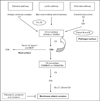Complement disorders and hemolytic uremic syndrome
- PMID: 23399570
- PMCID: PMC3758882
- DOI: 10.1097/MOP.0b013e32835df48a
Complement disorders and hemolytic uremic syndrome
Abstract
Purpose of review: Complement mediated hemolytic uremic syndrome (aHUS) accounts for a significant proportion of non-shiga toxin HUS. The purpose of this review is to outline the pathophysiology, clinical features and therapeutic options for aHUS.
Recent findings: In the last decade, strides have been made in identifying several new disease-causing mutations in complement-regulating proteins.
Summary: Complement mediated HUS (aHUS) has a worse prognosis compared with shiga toxin mediated HUS, often resulting in end stage renal disease. Early identification of aHUS is crucial so that plasma therapy can be initiated. After renal transplantation, there is very high risk of disease recurrence and graft loss. Eculizumab and combined liver-kidney transplantation offer promise for improved prognosis.
Conflict of interest statement
There are no conflicts of interest.
Figures

Similar articles
-
Atypical hemolytic uremic syndrome.Orphanet J Rare Dis. 2011 Sep 8;6:60. doi: 10.1186/1750-1172-6-60. Orphanet J Rare Dis. 2011. PMID: 21902819 Free PMC article. Review.
-
Posttransplant recurrence of atypical hemolytic uremic syndrome.J Nephrol. 2012 Nov-Dec;25(6):911-7. doi: 10.5301/jn.5000146. J Nephrol. 2012. PMID: 22760880 Review.
-
[Atypical hemolytic-uremic syndrome related to abnormalities within the complement system].Rev Med Interne. 2011 Apr;32(4):232-40. doi: 10.1016/j.revmed.2009.09.039. Epub 2011 Mar 3. Rev Med Interne. 2011. PMID: 21376430 French.
-
Tailored eculizumab therapy in the management of complement factor H-mediated atypical hemolytic uremic syndrome in an adult kidney transplant recipient: a case report.Transplant Proc. 2012 Dec;44(10):3037-40. doi: 10.1016/j.transproceed.2012.07.141. Transplant Proc. 2012. PMID: 23195022
-
Transplantation in atypical hemolytic uremic syndrome.Semin Thromb Hemost. 2010 Sep;36(6):653-9. doi: 10.1055/s-0030-1262887. Epub 2010 Sep 23. Semin Thromb Hemost. 2010. PMID: 20865642 Review.
Cited by
-
Iron accumulation drives fibrosis, senescence and the senescence-associated secretory phenotype.Nat Metab. 2023 Dec;5(12):2111-2130. doi: 10.1038/s42255-023-00928-2. Epub 2023 Dec 14. Nat Metab. 2023. PMID: 38097808 Free PMC article.
-
Therapeutic Complement Targeting in ANCA-Associated Vasculitides and Thrombotic Microangiopathy.Biomed Hub. 2016 Dec 13;1(3):1-11. doi: 10.1159/000453106. eCollection 2016 Sep-Dec. Biomed Hub. 2016. PMID: 31988889 Free PMC article. Review.
-
Proteinuria and hematuria in the neonate.Curr Opin Pediatr. 2016 Apr;28(2):202-8. doi: 10.1097/MOP.0000000000000323. Curr Opin Pediatr. 2016. PMID: 26845146 Free PMC article. Review.
-
Atypical Hemolytic Uremic Syndrome in a Pregnant Patient with a Thrombomodulin Gene Variant Treated with Plasma Exchange and Eculizumab.Am J Case Rep. 2023 Apr 30;24:e938896. doi: 10.12659/AJCR.938896. Am J Case Rep. 2023. PMID: 37120715 Free PMC article.
-
Streptococcus Pneumoniae-Associated Hemolytic Uremic Syndrome in the Era of Pneumococcal Vaccine.Pathogens. 2021 Jun 9;10(6):727. doi: 10.3390/pathogens10060727. Pathogens. 2021. PMID: 34207609 Free PMC article. Review.
References
-
- Dunkelberger JR, Song WC. Complement and its role in innate and adaptive immune responses. Cell Res. 2010;20:34–50. - PubMed
-
- Walport MJ. Complement. First of two parts. N Engl J Med. 2001;344:1058–1066. - PubMed
-
- Zipfel PF, Skerka C. Complement regulators and inhibitory proteins. Nat Rev Immunol. 2009;9:729–740. - PubMed
-
- Kavanagh D, Goodship TH. Membrane cofactor protein and factor I: mutations and transplantation. Semin Thromb Hemost. 2006;32:155–159. - PubMed
Publication types
MeSH terms
Substances
Grants and funding
LinkOut - more resources
Full Text Sources
Other Literature Sources
Research Materials

